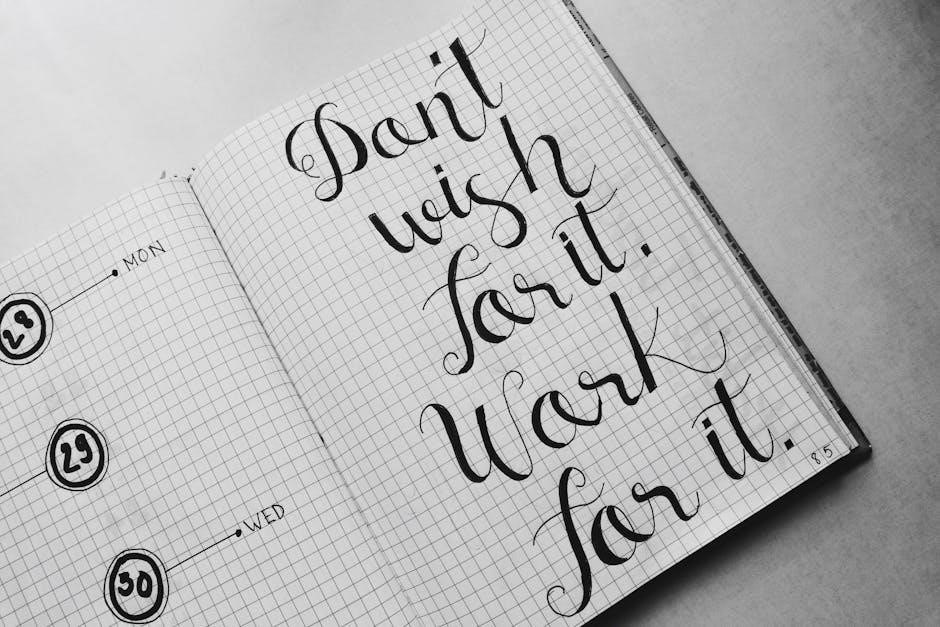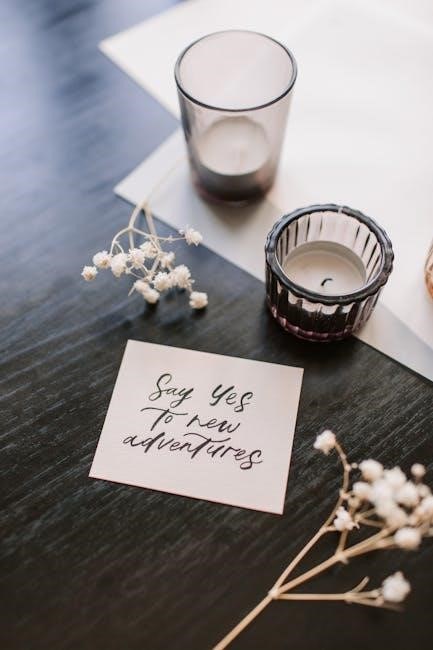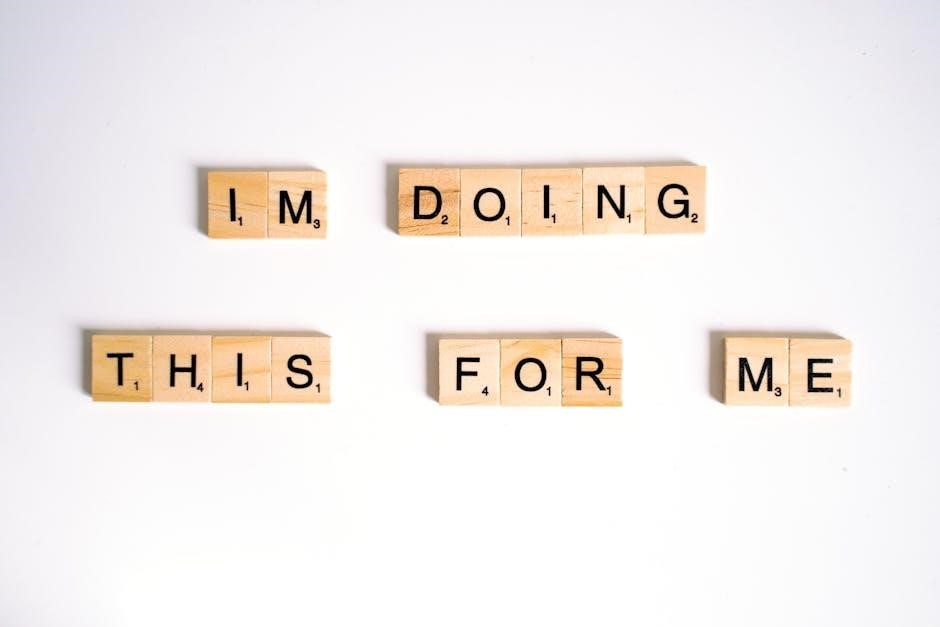Lettering guides are essential tools for creating consistent, beautiful hand lettering․ They provide structure, helping beginners master letter spacing, alignment, and style․ Use them to practice and refine your skills effectively․

1․1 What is Hand Lettering?

Hand lettering is the artistic process of creating decorative, handwritten-style letters․ It transforms words into visually appealing works of art, emphasizing creativity and personal style․ Unlike typography, hand lettering is manually crafted, allowing for unique flourishes and variations․ It combines calligraphy and illustration, making each letter a design element․ This art form is widely used in quotes, cards, and social media, offering a human touch in a digital world․ With the right tools and guides, anyone can master hand lettering, turning simple text into stunning, shareable art that expresses emotion and beauty․
1․2 The Importance of Lettering Guides
Lettering guides are indispensable for achieving consistency and precision in hand lettering․ They provide a structured framework, helping artists maintain uniform letter spacing, alignment, and proportions․ These tools are especially valuable for beginners, as they offer a clear starting point for practicing various styles․ Guides also help in mastering intricate details, such as flourishes and connections between letters․ By using lettering guides, creatives can focus on refining their technique while ensuring their work looks professional․ They are not just for learning; experienced artists also rely on them to explore new styles or perfect their craft․ Lettering guides are a foundational tool for anyone aiming to elevate their hand lettering skills․

Materials Needed for Hand Lettering
A good lettering guide, high-quality paper, and the right pens are essential․ These tools help create precise, beautiful lettering and ensure consistency in your artistic expressions․
2․1 Best Papers for Lettering
Choosing the right paper is crucial for hand lettering․ Smooth, heavy-weight papers (80-100 gsm) are ideal as they prevent bleeding and feathering․ Look for bleed-resistant or hot-press options for crisp lines․ Bristol board and high-quality watercolor papers are excellent choices due to their durable surfaces․ Avoid thin or textured papers, as they can hinder precision․ A4 or letter-sized sheets are convenient for practice․ Using a lettering guide on these papers ensures alignment and consistency․ Experiment with different textures to find what suits your style best․ Proper paper selection enhances both the process and the final result of your hand-lettered artwork․
2․2 Essential Lettering Pens and Brush Pens
High-quality pens and brush pens are vital for hand lettering․ Fineliners like Micron or Sakura are ideal for precise lines and details․ Brush pens, such as Tombow or Kuretake, offer flexibility for varying line widths․ Dual-tip markers like Copic or Prismacolor provide versatility for both fine and bold strokes․ Waterbrushes are great for water-based inks or watercolor effects․ Experiment with different nib sizes and ink flows to achieve desired styles․ Invest in a few key tools to start, then expand your collection as you explore various techniques․ The right pen can elevate your lettering, making it more expressive and professional․
2․3 Additional Tools for Beginners
Beyond pens and paper, several tools can enhance your hand lettering journey․ A light pad or tracing paper helps create consistent lettering by allowing you to trace guides or examples․ A pencil and eraser are essential for sketching and correcting letters․ A ruler or lettering guide ensures straight lines and proper alignment․ Practice pads with grid or dotted lines aid in maintaining uniform spacing and proportions․ A sharpener keeps your tools in optimal condition․ Lastly, a workbook or digital app with exercises and templates can provide structured practice․ These tools collectively help refine your skills and build confidence as you progress․

Basic Techniques for Hand Lettering
Lettering guides are foundational tools for mastering basic techniques․ They help create consistent letterforms, proper spacing, and alignment, making your hand lettering more readable and aesthetically pleasing from the start․
3․1 Understanding Lettering Styles
Understanding lettering styles is crucial for mastering hand lettering․ From modern calligraphy to brush script, each style has unique characteristics․ Lettering guides help you explore these styles, providing templates and examples to practice․ Start with simple sans-serif styles, then gradually experiment with more intricate scripts․ Pay attention to letterforms, spacing, and flourishes․ Using guides, you can learn to replicate styles accurately․ For beginners, starting with basic styles like print or casual script is recommended․ As you progress, incorporate more decorative elements․ Remember, consistency is key․ Practice regularly to develop muscle memory and confidence in your chosen style․ This foundation will enhance your creativity and versatility in hand lettering․
3․2 Step-by-Step Guide to Drawing Letters
Mastering lettering begins with a step-by-step approach․ Start by sketching light guidelines to ensure alignment․ Outline the letterforms using a pencil, then refine with a pen․ Practice basic strokes, such as verticals, horizontals, and curves․ Pay attention to letter spacing and consistency․ Use lettering guides to trace and replicate styles accurately․ Begin with simple letters like “A” or “C,” gradually progressing to more complex forms․ Break letters into parts, focusing on proportions and angles․ Erase guidelines carefully and add flourishes last․ Regular practice with these steps will improve your skills and confidence in drawing letters effectively․
Faux calligraphy is a versatile technique that mimics traditional calligraphy without specialized tools․ It involves manually adding weight to letter strokes using a marker or pen․ Start by writing a word in your normal handwriting, then identify the downstrokes․ Thicken these areas to create the illusion of calligraphy․ This method is perfect for beginners, as it requires minimal tools and practice․ Use lettering guides to maintain consistency in letter spacing and alignment․ Faux calligraphy is ideal for creating decorative quotes, cards, and social media content․ With patience and practice, you can achieve beautiful, calligraphy-like results using basic materials․
Advanced Lettering Techniques
Lettering guides enhance advanced techniques by ensuring precision and consistency․ They help refine intricate designs, explore styles, and maintain structure, elevating your creativity and skill in hand lettering․
4․1 Mastering Brush Script
Mastering brush script involves understanding fluid strokes and varying line widths․ Lettering guides help maintain consistency, ensuring each letter aligns perfectly․ Start with basic strokes, gradually incorporating flourishes․ Practice with high-quality tools to achieve smooth transitions․ Use guides to refine spacing and angles, essential for readability․ As you progress, experiment with creative variations while keeping the foundation strong․ Regular practice and reference to guides will enhance your skills, making your brush script both elegant and professional․ Patience and dedication are key to mastering this beautiful lettering style․
4․2 Creating Decorative Flourishes
Decorative flourishes add elegance to hand lettering, transforming simple words into artistic expressions․ Lettering guides help create consistent and balanced flourishes by providing a framework for spacing and alignment․ Start with basic strokes, such as swashes and curls, and gradually incorporate more intricate designs․ Practice varying line widths and pressure to achieve smooth transitions․ Use guides to ensure flourishes complement the text without overwhelming it․ Experiment with different tools, like brush pens, to enhance texture and flow․ Regular practice will refine your technique, allowing you to create beautiful, unique flourishes that elevate your lettering․ Mastery lies in blending creativity with precision․
4․3 Combining Letters into Words
Combining letters into words is a crucial step in hand lettering, requiring attention to spacing, alignment, and flow․ Lettering guides help maintain consistency, ensuring each letter connects harmoniously․ Start by practicing individual letters, then gradually merge them, focusing on natural transitions; Pay attention to kerning—the space between letters—to avoid overcrowding or gaps․ Use guides to align baselines and x-heights, ensuring uniformity․ Experiment with different styles, like script or serif, to see how letters interact․ Regular practice with various tools and styles will enhance your ability to create cohesive, visually appealing words․ This skill is foundational for crafting beautiful, professional-looking lettering pieces․
Common Mistakes and Solutions
Lettering guides help fix uneven spacing, inconsistent sizes, and slanted letters․ They provide alignment and consistency, ensuring your work looks professional and polished from the start․
5․1 Avoiding Uneven Letter Spacing
Uneven letter spacing is a common issue in hand lettering, but using lettering guides can help maintain consistency․ These guides provide a visual reference, ensuring each letter is evenly spaced․ By aligning your letters within the guide’s markings, you can achieve a professional look․ Start by lightly drawing the guide on your paper, then letter within the lines․ This technique is especially helpful for beginners, as it trains the eye to recognize proper spacing․ Over time, you’ll develop muscle memory, making it easier to space letters evenly without relying on the guide․ Practice regularly to master this skill․
5․2 Fixing Inconsistent Letter Sizes
Inconsistent letter sizes can make your hand lettering appear unprofessional․ To address this, use lettering guides to establish a consistent baseline and x-height․ These guides help you maintain uniformity by providing a visual reference for letter proportions․ Start by lightly drawing the guide lines on your paper, then letter within the marked boundaries․ This technique ensures that all letters align correctly and maintain the same height and width․ Practice regularly to develop muscle memory, as consistent sizing is key to creating polished designs․ Over time, you’ll find it easier to gauge letter sizes without relying on the guide, leading to more professional results․
5․3 Correcting Slanted Letters
Slanted letters can disrupt the balance of your hand lettering․ To correct this, use a lettering guide to establish a straight baseline․ Lightly draw a horizontal line with a pencil, ensuring all letters align to it․ Practice writing letters within this boundary, focusing on maintaining even angles․ For severe slants, experiment with grid paper or specialized guides that include slant lines for script styles․ Regular practice and attention to letter alignment will help you achieve straighter, more consistent results․ Over time, your muscle memory will improve, reducing the need for guides and enhancing the professionalism of your lettering․
Inspiration and Resources
Discover inspiration through free alphabets, templates, and online communities․ Explore step-by-step guides, workbooks, and tutorials to enhance your hand lettering skills and stay motivated throughout your creative journey․
6․1 Popular Lettering Styles for Beginners
For beginners, popular hand lettering styles include faux calligraphy, brush script, and block lettering․ Faux calligraphy mimics calligraphy with simple tools, while brush script offers fluid, connected letters․ Block lettering is great for clarity and precision․ These styles are ideal for practicing basic techniques and building confidence․ They also serve as a foundation for exploring more complex styles later․ Many tutorials and workbooks focus on these styles, providing step-by-step guidance․ Practicing these will help you develop muscle memory and improve your overall lettering skills․ Start with these styles to create beautiful, legible designs for quotes, cards, and social media posts․
6․2 Free Alphabets and Templates
Free alphabets and templates are invaluable resources for beginners in hand lettering․ Websites offer downloadable guides, practice sheets, and pre-designed lettering templates․ These tools help you master letterforms, spacing, and alignment without starting from scratch․ Templates are perfect for creating personalized quotes, cards, and social media posts․ Many platforms provide free alphabets in various styles, from modern to vintage, allowing you to experiment and find your favorite designs․ Using these resources can save time and inspire creativity, making your lettering journey more enjoyable and productive․ They are also great for practicing specific techniques and refining your skills before moving to advanced projects․
6․3 Where to Find Lettering Inspiration
Discovering inspiration for hand lettering is easier than ever, thanks to online platforms and creative communities․ Social media sites like Instagram and Pinterest are filled with stunning examples of lettering art․ Explore hashtags like #handlettering or #letteringinspiration to find trending styles and techniques․ Online forums and lettering groups share tips, challenges, and showcases of work․ Additionally, websites offer free alphabets, templates, and tutorials to spark creativity․ Blogs and YouTube channels dedicated to lettering provide step-by-step guides and motivational content․ By exploring these resources, you can gain ideas, learn new styles, and stay inspired throughout your lettering journey․ Regularly visiting these platforms will keep your creativity fresh and evolving․
Digital Tools for Lettering
Digital tools like Procreate and Adobe Illustrator offer advanced features for hand lettering, including customizable guides and brushes, enabling precise control and creative expression in your designs․
Procreate is a powerful digital tool for hand lettering, offering customizable brushes, guides, and layers․ Its intuitive interface makes it ideal for both beginners and professionals․ With Procreate, you can create stunning lettering designs, experiment with different styles, and refine your work effortlessly․ The app supports high-resolution exports, perfect for social media or printing․ Its vast brush library and adjustable settings allow for precise control, mimicking traditional tools like brush pens and markers․ Procreate also features an undo system and customizable guides, helping you achieve perfect alignment and spacing․ It’s a must-have for anyone looking to elevate their digital lettering skills․
7․2 Using Adobe Illustrator for Lettering
Adobe Illustrator is a professional tool for creating precise, scalable lettering designs․ Its vector-based capabilities allow for crisp, high-resolution output․ Use the pen tool to craft custom letterforms, or rely on type tools for quick adjustments․ Illustrator’s shape builder and pathfinder features enable intricate flourishes and decorative elements․ Layers and non-destructive editing make it easy to experiment and refine designs․ While it has a steeper learning curve than Procreate, Illustrator’s advanced features make it ideal for commercial projects․ Combine it with lettering guides for consistent alignment and spacing, ensuring professional-grade results for logos, signage, and digital art․
7․3 Best Apps for Digital Hand Lettering
Discover the best apps for digital hand lettering, perfect for creating stunning designs on-the-go․ Procreate and Adobe Illustrator are top choices, offering advanced tools for precision and creativity․ Procreate’s brush library and layer system make it ideal for detailed work, while Illustrator’s vector capabilities ensure scalability․ Other notable apps include Canva for quick, template-based designs and LetteringPad for beginners․ Apps like Calligraphy Art and Hand Lettering Guide provide tutorials and lettering guides to help refine your skills․ These tools cater to all skill levels, offering features like customizable brushes, undo options, and export capabilities․ They’re perfect for crafting beautiful lettering on mobile devices or desktops․

Practice and Improvement
Consistent practice with lettering guides helps refine skills․ Use workbooks and practice pages to master styles and techniques․ Track progress to see improvement over time․
8․1 Daily Practice Routines
Establishing a daily practice routine is crucial for improving hand lettering skills․ Begin with warm-up exercises using lettering guides to ensure consistency․ Dedicate 15-30 minutes daily to practice specific styles or techniques․ Start with basic alphabets, gradually incorporating more complex scripts․ Use practice pages to focus on letter spacing and alignment․ Incorporate drills like writing quotes or phrases to apply your skills creatively․ Track your progress by dating each practice session․ Over time, you’ll notice improvements in letter formation and overall style․ Consistency is key to mastering hand lettering, so make it a habit to practice every day․
8․2 Using Practice Pages Effectively
Practice pages are invaluable for refining hand lettering skills․ Start by tracing lettering guides to master shapes and spacing․ Focus on one style at a time, such as brush script or modern calligraphy․ Use grids to ensure consistent letter height and alignment․ Practice writing phrases or quotes to apply your skills creatively․ Review your work regularly to identify areas for improvement․ Experiment with different tools and techniques on separate pages․ Over time, you’ll see progress in your lettering consistency and style․ Make the most of practice pages by setting specific goals for each session, ensuring steady improvement in your craft․
8․3 Tracking Progress Over Time
Tracking your progress in hand lettering is crucial for improvement․ Regularly review your practice pages to see how your skills evolve․ Use a journal or app to document your journey, noting what works and what doesn’t․ Set milestones, like mastering a specific lettering style or achieving consistent spacing․ Celebrate small victories to stay motivated․ Compare your early work with recent pieces to visualize growth․ Share your progress with a community for feedback and encouragement․ Stay patient and persistent, as progress takes time․ By consistently tracking your development, you’ll refine your technique and gain confidence in your hand lettering abilities over time․

Lettering Projects and Applications
Hand lettering enhances various projects, from creating personalized cards to designing social media content․ Use lettering guides to craft beautiful quotes, adding artistic flair to your work․
9․1 Creating Hand-Lettered Quotes
Hand-lettered quotes are a popular way to add artistic flair to any project․ Using lettering guides ensures consistency and precision, making your quotes visually appealing․ Start by selecting meaningful words, then sketch letters with guides to maintain alignment․ Practice varying styles, from bold scripts to delicate lines, to match the quote’s mood․ Add flourishes or decorative elements for a personal touch․ Use high-quality paper and tools to enhance the final look․ Share your creations on social media or gift them as personalized art․ With patience and practice, your hand-lettered quotes will become stunning works of art․

9․2 Designing Personalized Cards
Personalized cards are a thoughtful way to express emotions, and hand lettering adds a unique touch․ Use lettering guides to ensure precise alignment and spacing, making your designs professional․ Start by selecting a meaningful message, then sketch letters with guides to maintain consistency․ Experiment with different styles, such as bold scripts or delicate lines, to match the occasion․ Add decorative flourishes or illustrations for a personal flair․ Use high-quality paper and tools to enhance the card’s appearance․ Whether for birthdays, weddings, or holidays, hand-lettered cards create lasting impressions․ With practice, your designs will become heartfelt, one-of-a-kind gifts․
9․3 Lettering for Social Media
Hand lettering on social media captivates audiences with its artistic appeal․ Use lettering guides to create visually striking posts that stand out․ Consistent spacing and alignment ensure readability, while creative styles engage viewers․ Experiment with bold scripts, minimalist designs, or decorative flourishes to match your brand․ Combine lettering with graphics or photos for dynamic content․ Share tutorials, quotes, or inspirational messages to connect with your audience․ Utilize high-quality images and editing apps to enhance your work․ Regularly posting lettering art builds a loyal following and showcases your creativity․ Make your social media content unforgettable with the beauty of hand lettering․

Community and Workshops
Joining online communities and attending workshops connects you with fellow lettering enthusiasts․ Lettering guides are often shared here, helping you refine your skills and stay inspired creatively․
10․1 Joining Online Lettering Communities
Joining online lettering communities is a great way to connect with fellow enthusiasts and learn from experienced artists․ These platforms often feature tutorials, challenges, and resources like lettering guides to help you improve․ Many communities share free alphabets and templates, which can be invaluable for beginners․ Additionally, you can participate in group projects, get feedback on your work, and stay updated on the latest trends․ Engaging with these communities can also provide motivation and inspiration, helping you stay consistent in your practice and grow as a lettering artist․ They are a valuable resource for anyone looking to enhance their skills․

10․2 Benefits of Attending Workshops
Attending workshops offers hands-on learning and personalized feedback, helping you refine your lettering skills․ Workshops provide structured lessons, often covering topics like lettering guides, brush script, and faux calligraphy․ They allow you to interact with experienced instructors and like-minded enthusiasts, fostering a supportive environment for growth․ Many workshops include practice pages and materials, giving you the tools to improve immediately․ Additionally, they often cover common mistakes and solutions, helping you avoid pitfalls․ Workshops can also introduce you to new styles and techniques, inspiring creativity and confidence․ Whether in-person or virtual, they are a valuable resource for enhancing your lettering journey․
10․3 Finding Local Lettering Groups
Discovering local lettering groups can enhance your learning experience by connecting you with fellow enthusiasts․ These groups often host workshops, share resources, and provide feedback․ Use social media platforms or local art communities to find meetups․ Many groups focus on specific techniques, such as brush script or faux calligraphy, and may offer lettering guides․ Attending these gatherings allows you to practice alongside others, gaining new insights and inspiration․ Local groups also foster a sense of belonging and motivation, helping you stay committed to improving your skills․ They often share tips on materials, practice pages, and common mistakes to avoid, enriching your journey․
Lettering guides are invaluable for achieving consistent, beautiful results․ They help refine skills, ensuring proper spacing and alignment․ Use them to enhance your creativity and mastery of hand lettering․
11․1 Final Tips for Success
Mastering hand lettering requires patience and consistent practice․ Start with lettering guides to ensure alignment and spacing․ Experiment with various tools and styles to find what suits you best․ Regularly review your work to track progress and identify areas for improvement․ Join online communities for inspiration and feedback․ Attend workshops to refine your skills and stay updated with trends․ Most importantly, embrace creativity and enjoy the journey of transforming simple letters into stunning works of art․ Remember, practice is key to achieving mastery in this beautiful craft․
11․2 Encouragement for Continuous Learning
Continuous learning is vital for growth in hand lettering․ Embrace challenges and view mistakes as opportunities to improve․ Stay curious and explore new styles, tools, and techniques․ Join online communities and workshops to gain insights and inspiration․ Set achievable goals and celebrate progress, no matter how small․ Remember, mastery takes time, so stay committed and enjoy the creative journey․ Keep experimenting, learning, and pushing your boundaries to unlock new possibilities in hand lettering․
